

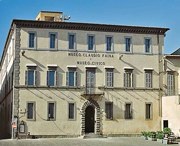
This collection is currently housed in three rooms on the ground floor of Palazzo Claudio Faina.
Entrance Room
Finds from the Cannicella Necropolis
The following are from the site of the Cannicella Necropolis.
Inscription (ca. 550 BC)

This inscription “thval veal” reveals that the temple associated with the necropolis was dedicated to Vei (Demeter). It is discussed in context in the page Early Etruscan Inscriptions.
“Venus” of Cannicella (ca. 550 BC)
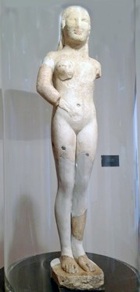
Funerary cippus (late 6th century BC)
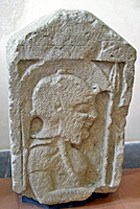
Terracotta Decoration


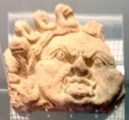
The following exhibits also came from the site of the temple:
-
✴the lovely terracotta head of a woman;
-
✴a series of terracotta antefixes representing one or more goddesses; and
-
✴a terracotta antefix representing a gorgon.
Antefix from the Campo della Fiera (4th century BC)
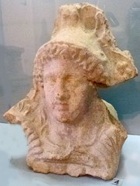
Finds from Palazzo Buzi (5th century BC)
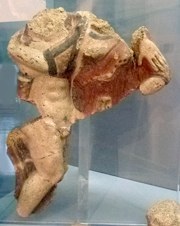
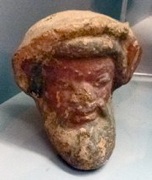
The following terracotta objects were found at Palazzo Buzi [when??]:
-
✴a fragment of a painted terracotta relief of a snaked man; and
-
✴the head of a satyr.
Room on the Right
Finds from the Tempio del Belvedere
A number of objects were found during the construction of the nearby Pozzo di San Patrizio in 1527-32 pointed to an important Etruscan cult site. The remains of the temple itself (now known as the the Tempio del Belvedere) were discovered during roadworks in 1828. Excavations on the site in 1923 unearthed the floor plan and a number of decorative elements of exceptional quality. Their dating on stylistic grounds pointed to the rebuilding or extensive redecoration of the temple in the late 5th or early 4th century BC. The following are in the Museo Civico:
Nortia ?/Athena (ca. 450 BC)
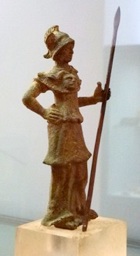
Virgil (Aeneid 8.435–8) described the aegis in a scene set in the workshop of Vulcan (Hephaestus):
“a chilling aegis, the breastplate of Pallas [Athena],
[the Cyclopes] competing to burnish its serpent scales of gold,
its interwoven snakes, and the Gorgon herself
on the goddess’s breast, with severed neck and rolling eyes”.
Although Virgil imagined the aegis as a breastplate, its representation as a cloak (as here) is more usual. The Gorgon that Virgil describes “on the goddess’s breast” is clear visible on the bronze figure discussed here.
Bronze Votive Offerings (ca. 450 BC)
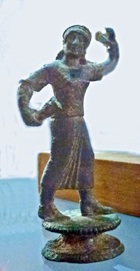
Terracotta Antefixes (ca. 400 BC)


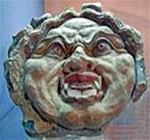
The most impressive of these include:
-
✴a head of an old man;
-
✴a figure in high relief of a nude man in a cloak; and
-
✴a head of a gorgon.
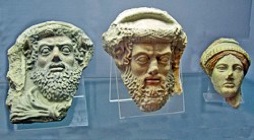
A number of other lovely antefixes are displayed in a separate case.
Room on the Left
Finds from Necropolis of Crocifisso del Tufo
The following came from the necropolis of Crocifisso del Tufo:
Warrior head (ca. 550 BC)
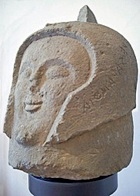
The cippus, which is in the form of the head of a warrior, was discovered above the tomb. According to the inscription on the right of the helmet, it marked the grave of Larth Cuperes, son of Aranth. This name is unlike others found in Orvieto, and it is thought that Larth might have been a foreign mercenary who settled in the city.
The inscription is discussed in context in the page Early Etruscan Inscriptions.
Funerary Cippus (6th century BC)
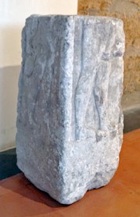
Finds from Outside Orvieto
Sarcophagus from Torre San Severo (ca. 350 BC)
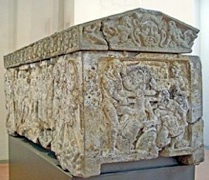
This sarcophagus, which was discovered in 1912 at Torre San Severo, south of Porano, probably belonged to a family from the rural aristocracy. It is covered with originally polychromed reliefs depicting stories from Greek legend:
-
✴Those on the long sides illustrate scenes from the Illiad:
-
✴Achilles sacrificing Trojans on the tomb of Patroclus; and
-
✴Neoptolemus sacrificing Polyxena at the tomb of Achilles.
-
✴Those on the short sides illustrate scenes from the Odyssey:
-
✴Ulysses sacrificing a goat at the gates of Hades as he prepares to visit the seer Tiresia (illustrated); and
-
✴Ulysses and Circe.
Sarcophagus from Pietra Campana (ca. 300 BC)
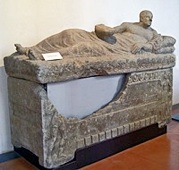
This sarcophagus was apparently one of three that were discovered in 1896 in a chamber tomb at Pietra Campana, a location between Porano and Orvieto. The deceased is depicted reclining on the lid. The reliefs on the sides are mostly decorative, with two demons (a male on the left and a female on the right) to the sides.
Statutes of Orvieto
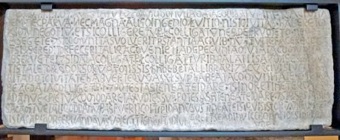
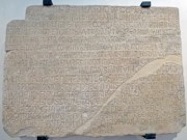
Statute of 1209 Amendment of 1220
This inscription, which is inscribed on a slab that has an earlier relief on the back, defines:
-
✴the taxes due to the Commune in times of need, which varied according to the wealth of each citizen; and
-
✴the compensation to be paid for privately-owned horses that were requisitioned in times of war.
The shorter inscription contains slight amendments made in 1220.

